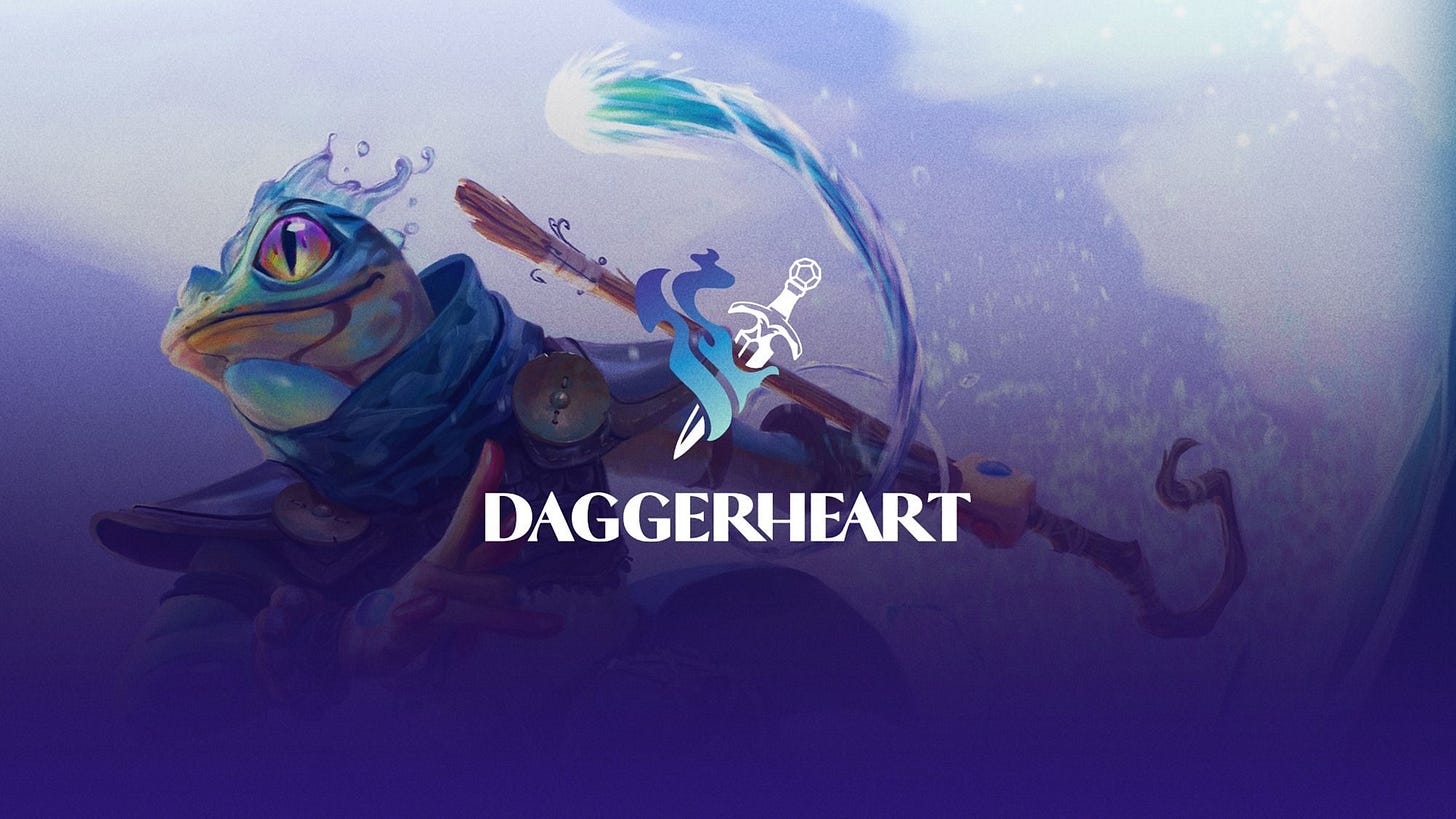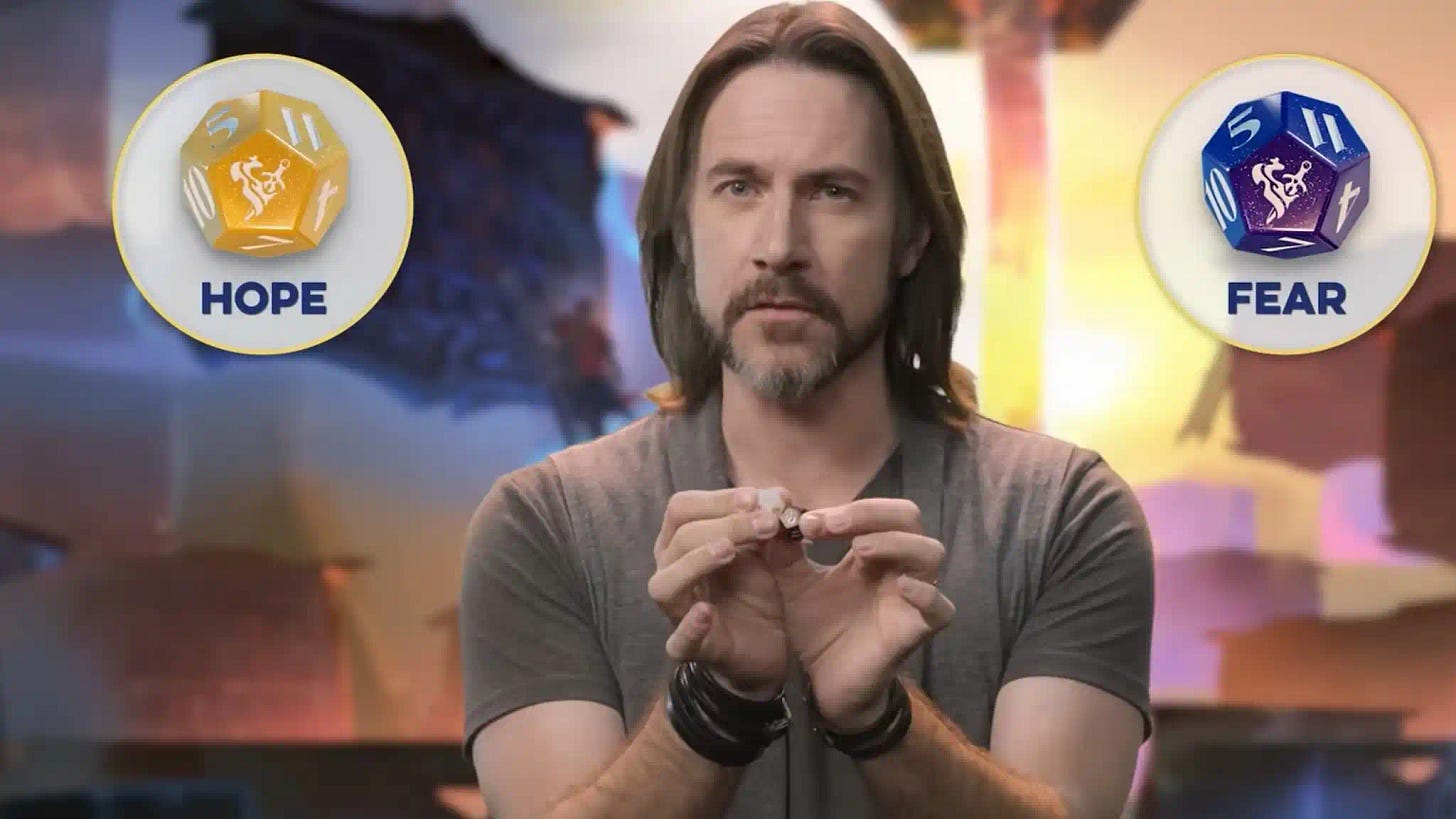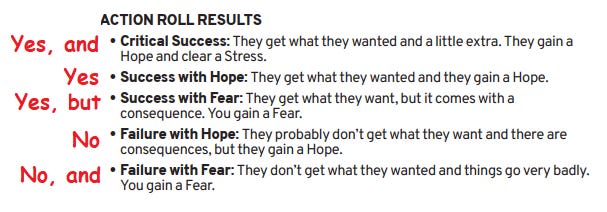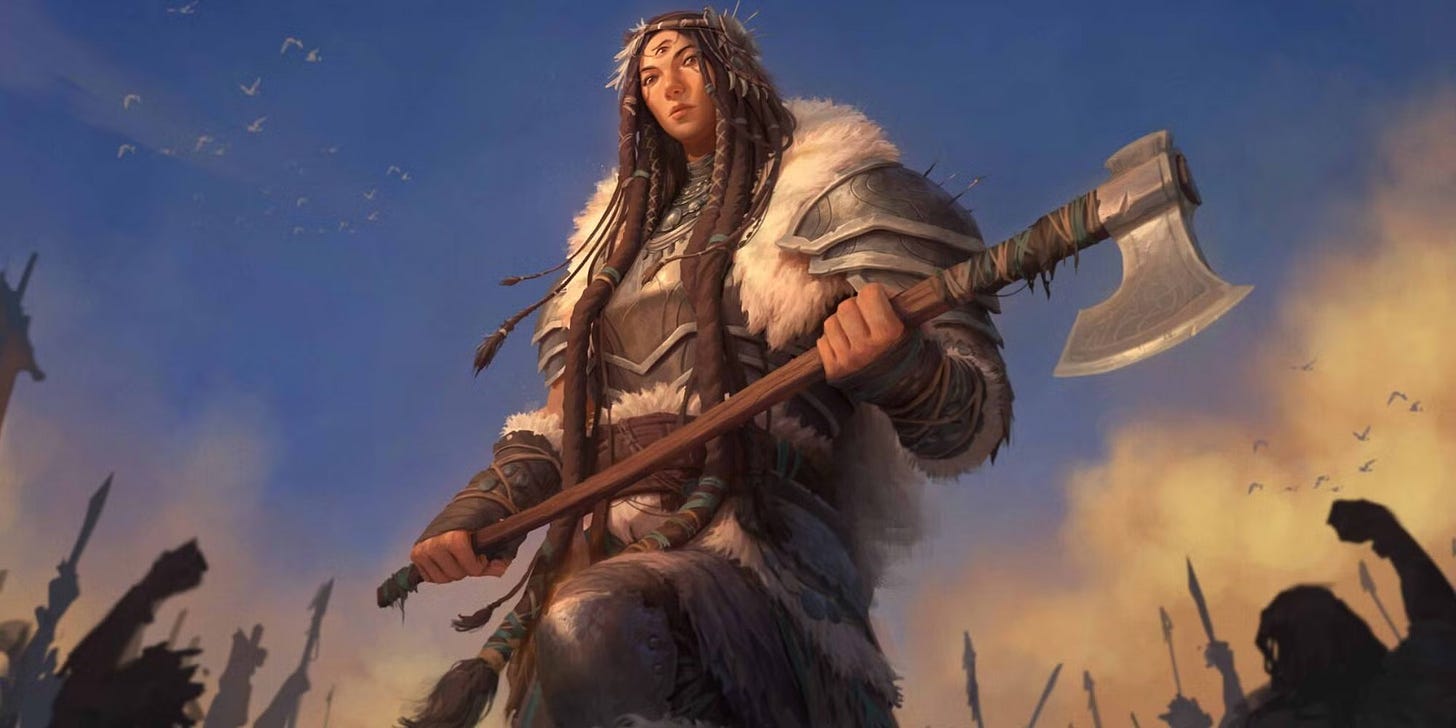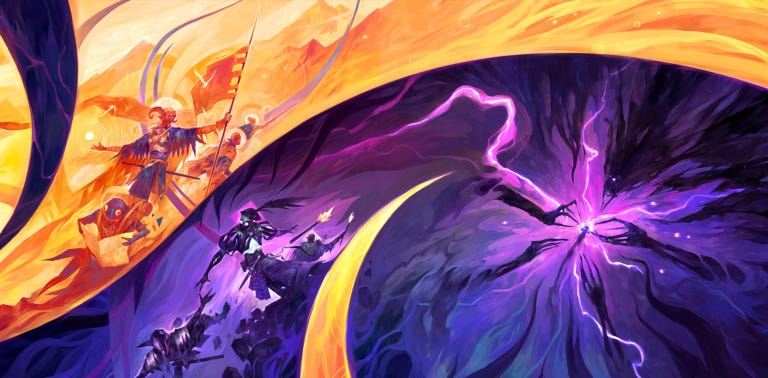Daggerheart, First Impression
"This is like Blades in the Dark if that game would run on D&D-4E"
First things first,
I played the game as a player and will express my impression about that side of the game. Mostly. I did read the GM section after the game just to see what my GM had to handle to make the session run and I have some opinions about that. I also went mostly blind into this without knowing much about it.
All Art in this post in from the Daggerheart RPG System.
If it looks cool check out the artists that worked on it.
Character Creation
I was given the words “Just pick what you like. The books says as much.” by my GM and feeling a mix of curiosity and pettiness about such advice I went with a simple Human Seaborn Warrior (I’m probably one of the handful of people on this globe that enjoys playing humans). It took me around 15 minutes to make a character and that is in addition to asking my GM a bunch of questions. It’s stupidly easy if you are a bit familiar with how tags work in games like City of Mist, otherwise you might struggle a bit with experiences. Never regretted any of my choices during play.
What I liked:
• I really like the shift away from backgrounds as “Jobs” to geo-economic society templates in the form of communities. Sounds sarcastic, but no I mean this. This is development in the right direction. It’s a way better system to emulate where you came from.
• No more puzzling around for the best stat combinations. Now I say this as someone who enjoys that theory-crafting mini-game, but with D&D type games it felt more like a tax where I had to do it just so my character could perform the way I wanted them to.
• Experiences combine skills, jobs and traits into one subsystem and it makes things so much cleaner its unreal. Also keeps the numbers down but I will talk about that later.
What I found strange/bold:
• There is no obvious way to make a normal guy. For example, try making a humble farmers son from the central regions that is bored with life and seeks adventure. You probably have to reflavor the Highborn community a bit and change some of the class flavor to better represent the mundane origins. On the other hand, I also massively respect the decision to just not make obvious boring choices for both world-building and character building.
The Dice Mechanic
This is the core of the system where everything is focused around. If you like it you like the system if you don’t you will hate it. The process is as follows:
Duality Dice [2d12]
+ Stat
(-/+ Dis/Advantage [d6] )
(+ Experience)
(+ Skill/s)
(+ Items)
——————————
Total Number vs DC
Note that the stuff in brackets needs to be activated or somehow set up and earned. So in most situations you will just roll your 2d12+Stats. Which btw are level capped. Only at level 2,5,8 can you unlock the option to raise Stats by one point for that entire tier. But if you want to increase the likelihood of success you have to go and make use of your Hope resource, which you can used to activate the afford mentioned stuff in the brackets. And you only get those by rolling. And only if your Hope-Die supersedes the Fear-Die. Otherwise you are giving your GM fiat points they can spend for bad stuff.
The two samey yet very different d12, just adds a ton of drama potential to a roll, especially because the resolution mechanic is straight out of the PBTA playbook.
The 50/50 chance of switching between player and GM turns is also really clean. No awkward initiative rolls and having to keep track of where everyone’s turn is. It just keeps the scene rolling. And the possibility of having multiple player turns in a row is such a boon to the feeling of momentum. If you are on a roll you are on a roll. And the opposite is true as well. Roll a bunch of time with fear and you will feel the approaching doom.
Here is also a bit of probability talk:
• The interesting thing here is that even at Level 1 if you focus on your +2 stat you end up with a ~54% of making an Average-DC roll. At tier 2 you will have a ~61% chance of making an Average-DC with your main stat and a ~54% with your secondaries.
• It probably makes life way easier for “on the fly” GMs as the curve more or less guarantees that most rolls will be within +/- 5 of the peak. So if you want your Players to more often win you want to probably set your go-to DC at 14+Tier, or if you want them to feel confident about their secondary stats you go with 13+Tier.
• High numbers won’t help you as much in Daggerheart as in other D&D-likes. It kind of comes down to the hope vs fear mechanic. The more you roll with fear the more options your GM has to make it harder for you. And considering it’s a straight 50/50 chance, they are encouraged to do so. This is probably the biggest balance aspect that you can’t optimize your way out of.
• Also fun fact, the crit chance is at 8.3%
Some advice:
• If you want to do another action right after your previous one, just ask if it’s ok for everyone that you do so. During our play we never had an issue with players wanting to spotlighthog. This might be an issue with random people, but if you just go with “taking turns is the default” and “if you want more you ask” it seems like a non issue.
What I wonder about:
• If d14 were industry standard you could probably have an optional rule for shifting the chances of hope and fear. One being a d10 and the being a d14. It would probably affect balance in some way, but also the feeling would be massively different.
Combat
We only had a couple of fights, but those were rather fun and kind of deadly. As mentioned, combat is just another scene and not its very own phase which makes transitions in and out of it really smooth and it led to us doing something I have only seen a couple of times in RPG history, the heroes actually fleeing a combat that was becoming too spicy. Because it was just that easy. No worry about turn order or opportunity attacks or anything like that.
What I liked:
• I love DMG thresholds. They combine the best of both worlds. You got big number damage rolls and you got basically no math. All you got to do is look if it reached the threshold number and then fill out some boxes. Smooth.
• Love that combat is a bit auto balanced (kinda), simply because of the dice mechanic. Stat-blocks still matter, but now action economy is not such a big deal.
• Splitting AC into evasion, thresholds and armor is brilliant. Wearing armor now feels different then playing a slippery PC. I really dig the mechanical validation.
• I always liked rests as a mechanic ever since I first played Darkest Dungeon. So I’m really happy to see that they have expanded upon those in this system.
• Weapons having special features is really fun.
What I worry about:
• The lack of a minimal DMG threshold .. is weird. Idk if its intended that tanks have a harder time with swarms then evasion based classes, but it kind of does seem so when you get a negative to evasion from armor. Maybe the intention is that high DMG enemies go for the tanks and the minions go for the rest? But that would be problematic if it’s ever the reverse.
Whats on my mind:
• The HP system is rather interesting because you could probably cook up some subsystem with it like this:
I think especially OSR folks need to look into this. They would probably love the slot like HP system of Daggerheart.
Game Mastering
As mentioned, I did not GM so take most of what you will read here with a grain of salt. The game is build to support a game oriented around a grand meta story and weaving individual character stories into it. And it does a really good job at offering a lot of advice and a good amount of structure for how to do that. When I first tried to GM a story based RPG I consumed a ton of advice videos and blogs (shout out to “How to be a great GM” on YT) on how to do it properly and this book still had something to offer for me on that front. Arc structuring, theming, faction fronts, story clocks, GM moves and intrusions, took from nearly every book I know of and combined some of the best stuff. I also like that they included mechanics for some of their campaign settings. Many books just talk the talk and let the GM figure it out, but not in this one. They got you.
Well and here is where I start to be more critical.
I’m not a story oriented GM. I prefer running sandboxes. And the book does give you no support what so ever in that direction. I had some hope that maybe there was something in there just for completions sake and to target a bigger audience, but no. You got one table on “Objectives”. Would have been cool as PBTA mechanics are naturally good at sandbox games even without trying. But to be fair, that’s a very low hanging fruit I’m picking here as the book does not advertise itself what so ever to be such a system. You just have to do it yourself, which brings me to:
There is no homebrewing or hacking guide. In the enemies section there is an example listed for each enemy role as to how someone would go about creating a homebrew stat-block. Which is also written in the form of a suggestion. “Make what feels right and fix it on the fly” was the feeling I got from it (low key anxiety inducing). The section on improvised stat blocks however was very useful to understand some of the basic design rules and for having a “basic generic template” present. Would be nice if there would also be “basic role templates” you could just add to your custom creation. And that’s also all the support you get for brewing. No guides for ancestries, classes, communities, cards or loot. Reflavoring and orienting around existing material will probably be enough to get the math right, but idk why a section about it couldn’t be included simply for conveniences and times sake.
Speaking about convenience, it seems like you have to keep track of a lot of things during the game. Consequences from fear/hope rolls, how to use your fear tokens, making GM moves, deciding on a DC, scene types, beats, NPCs, spotlight management, monitoring combat, etc. You are the oil and the glue that makes the machine work. And this is problematic because the more stuff you onload onto the GM the faster decision fatigue kicks in and the sooner burnout happens. It’s probably why max level is set to 10, to keep it short. And preventative care is usually to try and offload stuff onto the system (most often random tables), the players (giving them more narrative control), or just telling you to not care about it (OSR and balance). Despite having a lot of influence from more loose/lax type games it still maintains the core principle of any trad game, to more or less the fullest extend, in that the GM is at the center of the game.
Again, these are just the risks I see without having been in the GM position, so don’t take what you read as a concrete statement from me.
Final Statement
I really like it. You should try it.
8.5/10


